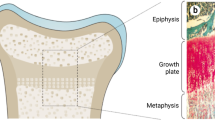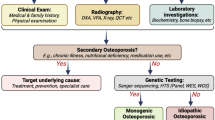Abstract
ᅟObjectives
Vitamin-D-dependent rickets type 1A (VDDR1A) is a rare inherited disease caused by defective activation of vitamin D. The aim of the study was to describe the craniofacial characteristics and the dental phenotype of patients with genetically confirmed VDDR1A. The VDDR1A findings were compared to findings in patients with X-linked hypophosphatemia (XLH) and healthy controls.
Material and methods
Ten patients with VDDR1A were identified. The reference group for the comparison of cephalometric findings was 49 adults without chronic disease. The reference group for the comparison of dental findings was 30 adults with XLH. Clinical examination, clinical photos, and radiographs were obtained. Cephalometric analysis was performed. Photos and radiographs were visually evaluated.
Results
The depth of the posterior cranial fossa (d-p and d-s-iop) in VDDR1A adults was reduced compared to the reference group (p < 0.05). Five (83%) of six adults with VDDR1A and one (4%) of 25 adults with XLH had enamel hypoplasia on several incisors and/or canines (p < 0.001). Three (75%) of four adults with VDDR1A and none of 16 adults with XLH had several first molars with enamel hypoplasia (p = 0.004). Five of 7 (71%) adults with VDDR1A and 24 of 30 (80%) adults with XLH had endodontically affected teeth.
Conclusions
The dental aberration of VDDR1A is more in line with the dental aberration of nutritional rickets than with the dental aberrations in XLH, suggesting the combination of low availability of both calcium and phosphate to be critical in periods of enamel formation.
Clinical relevance
Knowledge on craniofacial and dental aberration in patients with rare diseases, e.g., inherited rickets, is of importance to the dental practitioner, especially during diagnostics and treatment in special care units.





Similar content being viewed by others
References
Zambrano M, Nikitakis NG, Sanchez-Quevedo MC, Sauk JJ, Sedano H, Rivera H (2003) Oral and dental manifestations of vitamin D-dependent rickets type I: report of a pediatric case. Oral Surg Oral Med Oral Pathol Oral Radiol Endod 95(6):705–709. doi:10.1067/moe.2003.116
Nikiforuk G, Fraser D (1981) The etiology of enamel hypoplasia: a unifying concept. J Pediatr 98(6):888–893
Beck-Nielsen SS, Brock-Jacobsen B, Gram J, Brixen K, Jensen TK (2009) Incidence and prevalence of nutritional and hereditary rickets in southern Denmark. Eur J Endocrinol 160:491–497
Kitanaka S, Takeyama K, Murayama A, Sato T, Okumura K, Nogami M, Hasegawa Y, Niimi H, Yanagisawa J, Tanaka T, Kato S (1998) Inactivating mutations in the 25-hydroxyvitamin D3 1alpha-hydroxylase gene in patients with pseudovitamin D-deficiency rickets. N Engl J Med 338(10):653–661. doi:10.1056/NEJM199803053381004
Wang X, Zhang MY, Miller WL, Portale AA (2002) Novel gene mutations in patients with 1alpha-hydroxylase deficiency that confer partial enzyme activity in vitro. J Clin Endocrinol Metab 87(6):2424–2430. doi:10.1210/jcem.87.6.8534
Kim CJ, Kaplan LE, Perwad F, Huang N, Sharma A, Choi Y, Miller WL, Portale AA (2007) Vitamin D 1alpha-hydroxylase gene mutations in patients with 1alpha-hydroxylase deficiency. J Clin Endocrinol Metab 92(8):3177–3182. doi:10.1210/jc.2006-2664
Durmaz E et al (2012) Clinical and genetic analysis of patients with vitamin D-dependent rickets type 1A. Clin Endocrinol (Oxf) 77(3):363–369. doi:10.1111/j.1365-2265.2012.04394.x
Kim CJ (2011) Vitamin D dependent rickets type I. Korean J Pediatr 54(2):51–54. doi:10.3345/kjp.2011.54.2.51
Delvin EE, Glorieux FH (1981) Serum 1,25-dihydroxyvitamin D concentration in hypophosphatemic vitamin D-resistant rickets. Calcif Tissue Int 33(2):173–175
Kato S, Yanagisawa J, Murayama A, Kitanaka S, Takeyama K (1998) The importance of 25-hydroxyvitamin D3 1 alpha-hydroxylase gene in vitamin D-dependent rickets. Curr Opin Nephrol Hypertens 7(4):377–383
Nikiforuk G, Fraser D (1979) Chemical determinants of enamel hypoplasia in children with disorders of calcium and phosphate homeostasis. J Dent Res 58(Spec Issue B):1014–1015
Beck-Nielsen SS, Brusgaard K, Rasmussen LM, Brixen K, Brock-Jacobsen B, Poulsen MR, Vestergaard P, Ralston SH, Albagha OM, Poulsen S, Haubek D, Gjorup H, Hintze H, Andersen MG, Heickendorff L, Hjelmborg J, Gram J (2010) Phenotype presentation of hypophosphatemic rickets in adults. Calcif Tissue Int 87:108–119
The HYP C (1995) A gene (PEX) with homologies to endopeptidases is mutated in patients with X-linked hypophosphatemic rickets. The HYP Consortium. Nat Genet 11(2):130–136
Beck-Nielsen SS (2012) Rickets in Denmark. Dan Med J 59(2):B4384
Andersen MG, Beck-Nielsen SS, Haubek D, Hintze H, Gjorup H, Poulsen S (2012) Periapical and endodontic status of permanent teeth in patients with hypophosphatemic rickets. J Oral Rehabil 39(2):144–150
Chaussain-Miller C, Sinding C, Wolikow M, Lasfargues JJ, Godeau G, Garabedian M (2003) Dental abnormalities in patients with familial hypophosphatemic vitamin D-resistant rickets: prevention by early treatment with 1-hydroxyvitamin D. J Pediatr 142(3):324–331
Opsahl Vital S, Gaucher C, Bardet C, Rowe PS, George A, Linglart A, Chaussain C (2012) Tooth dentin defects reflect genetic disorders affecting bone mineralization. Bone 50(4):989–997. doi:10.1016/j.bone.2012.01.010
Gjørup H, Kjaer I, Sonnesen L, Haubek D, Beck-Nielsen SS, Hintze H, Poulsen S (2011) Craniofacial morphology in patients with hypophosphatemic rickets: a cephalometric study focusing on differences between bone of cartilaginous and intramembranous origin. Am J Med Genet A 155A:2654–2660
Beck-Nielsen SS, Brixen K, Gram J, Brusgaard K (2012) Mutational analysis of PHEX, FGF23, DMP1, SLC34A3 and CLCN5 in patients with hypophosphatemic rickets. J Hum Genet 57(7):453–458
Solow B (1966) The pattern of craniofacial associations. Department of Orthodontics, The Royal Dental College, Copenhagen
Bjørk A (1975) Kæbernes relation til det øvrige kranium. In: Lundström I (ed) Nordisk Lärobok i Ortodonti. Sveriges Tandläkarförbunds Förlagsförening, Stockholm, pp 69–110
Axelsson S, Kjaer I, Bjornland T, Storhaug K (2003) Longitudinal cephalometric standards for the neurocranium in Norwegians from 6 to 21 years of age. Eur J Orthod 25(2):185–198
Caspersen LM, Kjaer I, Sonnesen L (2010) How does occipitalization influence the dimensions of the cranium? Orthod Craniofac Res 13:162–168
Houston WJB (1983) The analysis of errors in orthodontic measurements. Am J Orthod 83:382–390
Orstavik D, Kerekes K, Eriksen HM (1986) The periapical index: a scoring system for radiographic assessment of apical periodontitis. Endod Dent Traumatol 2(1):20–34
AlQahtani SJ, Hector MP, Liversidge HM (2010) Brief communication: The London atlas of human tooth development and eruption. Am J Phys Anthropol 142(3):481–490. doi:10.1002/ajpa.21258
Ribeiro TR, Costa FW, Soares EC, Williams JR Jr, Fonteles CS (2015) Enamel and dentin mineralization in familial hypophosphatemic rickets: a micro-CT study. Dento Maxillo Facial Radiol 44(5):20140347. doi:10.1259/dmfr.20140347
Boukpessi T, Septier D, Bagga S, Garabedian M, Goldberg M, Chaussain-Miller C (2006) Dentin alteration of deciduous teeth in human hypophosphatemic rickets. Calcif Tissue Int 79(5):294–300. doi:10.1007/s00223-006-0182-4
Chaussain-Miller C, Sinding C, Septier D, Wolikow M, Goldberg M, Garabedian M (2007) Dentin structure in familial hypophosphatemic rickets: benefits of vitamin D and phosphate treatment. Oral Dis 13(5):482–489. doi:10.1111/j.1601-0825.2006.01326.x
Murayama T, Iwatsubo R, Akiyama S, Amano A, Morisaki I (2000) Familial hypophosphatemic vitamin D-resistant rickets: dental findings and histologic study of teeth. Oral Surg Oral Med Oral Pathol Oral Radiol Endod 90(3):310–316
Abe K, Masatomi Y, Nakajima Y, Shintani S, Moriwaki Y, Sobue S, Ooshima T (1992) The occurrence of interglobular dentin in incisors of hypophosphatemic mice fed a high-calcium and high-phosphate diet. J Dent Res 71(3):478–483
Pindborg JJ (1970) Disturbances in tooth formation; etiology. In: Pindborg JJ (ed) Pathology of the dental hard tissues. Munksgaard, Copenhagen, pp 77–133
Pinhasi R, Shaw P, White B, Ogden AR (2006) Morbidity, rickets and long-bone growth in post-medieval Britain—a cross-population analysis. Ann Hum Biol 33(3):372–389. doi:10.1080/03014460600707503
Davit-Beal T, Gabay J, Antoniolli P, Masle-Farquhar J, Wolikow M (2014) Dental complications of rickets in early childhood: case report on 2 young girls. Pediatrics 133(4):e1077–e1081. doi:10.1542/peds.2013-0733
Hallas D, Herman NG, Benichou L, Morales EL, Touchette L (2015) Management of a child with nutritional rickets, multiple cavities, enamel hypoplasia, and reactive attachment disorder. J Pediatr Health Care 29(3):283–288. doi:10.1016/j.pedhc.2014.11.010
Grahnen H, Selander P (1954) The effect of rickets and spasmophilia on the permanent dentition. I. The effect on the teeth. Odontol Revy 5(1):7–26
Nordgarden H, Lima K, Skogedal N, Folling I, Storhaug K, Abrahamsen TG (2012) Dental developmental disturbances in 50 individuals with the 22q11.2 deletion syndrome; relation to medical conditions? Acta Odontol Scand 70(3):194–201. doi:10.3109/00016357.2011.629624
Klingberg G, Dietz W, Oskarsdottir S, Odelius H, Gelander L, Noren JG (2005) Morphological appearance and chemical composition of enamel in primary teeth from patients with 22q11 deletion syndrome. Eur J Oral Sci 113(4):303–311. doi:10.1111/j.1600-0722.2005.00223.x
Ranggard L, Ostlund J, Nelson N, Noren JG (1995) Clinical and histologic appearance in enamel of primary teeth from children with neonatal hypocalcemia induced by blood exchange transfusion. Acta Odontol Scand 53(2):123–128
Ranggard L, Noren JG (1994) Effect of hypocalcemic state on enamel formation in rat maxillary incisors. Scand J Dent Res 102(5):249–253
Author information
Authors and Affiliations
Corresponding author
Ethics declarations
Conflict of interest
Signe Sparre Beck-Nielsen received payment from Pharmacosmos for participation in an expert meeting. Hans Gjørup and Dorte Haubek declare that they have no conflict of interest.
Funding
This work was supported by grants from The Danish Dental Association and The Public Health Dentists Association in Denmark.
Ethical approval
All procedures performed in the present study involving human participants were approved by the Ethics Committee of Southern Denmark (record # M-2678-05) and by the Danish Data Protection Agency (record # 2008-41-2187) and in accordance with the 1964 Helsinki Declaration and its later amendments or comparable ethical standards.
Informed consent
Informed consent was obtained from all individual participants included in the study and/or from their parents.
Rights and permissions
About this article
Cite this article
Gjørup, H., Beck-Nielsen, S.S. & Haubek, D. Craniofacial and dental characteristics of patients with vitamin-D-dependent rickets type 1A compared to controls and patients with X-linked hypophosphatemia. Clin Oral Invest 22, 745–755 (2018). https://doi.org/10.1007/s00784-017-2149-4
Received:
Accepted:
Published:
Issue Date:
DOI: https://doi.org/10.1007/s00784-017-2149-4




